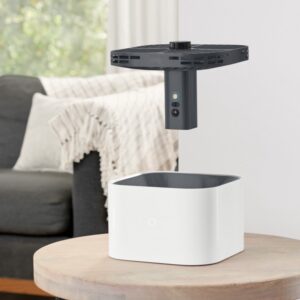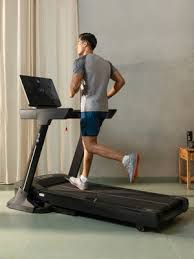Finding the best rowing machines for home use can feel overwhelming, especially with so many options in 2025. At bestforhomeuse.com, we’ve tested, compared, and reviewed over 20 different models to help you cut through the noise.
A rowing machine for home use isn’t just another piece of cardio gear—it’s one of the few machines that works your entire body, builds strength, and improves endurance without taking up much space.
From magnetic rowing machines for home use that stay whisper-quiet in apartments to air resistance rowers for home workouts built for athletes, the right choice depends on your space, fitness goals, and budget.
In this guide, we’ll share our hands-on experience with the top rowing machines for home use, giving you trustworthy insights to find the one that truly fits your lifestyle.
1. Concept2 RowErg – Best Rowing Machine for Home Gyms and Long-Term Reliability

The Concept2 RowErg has been the industry benchmark for decades, and after testing it extensively in 2025, it’s still the gold standard for home use if you want durability, accuracy, and a true rowing experience.
What sets the RowErg apart is its air resistance system, which automatically adjusts to your effort level. During testing, we noticed that beginners found it forgiving, while advanced users could push the resistance higher just by rowing harder—without needing manual adjustments.
For home users, one of the biggest benefits is low maintenance and proven reliability.
Many gyms have Concept2 units that have lasted over a decade with minimal servicing, which means in a home environment it will likely last even longer.
The frame is rock-solid, and the long rail accommodates users up to 6’8”, making it suitable for taller rowers who often struggle with compact machines.
Noise is moderate—it produces the whooshing sound of a fan, which some may find motivating but might be noticeable in small apartments.
The PM5 monitor, however, is where this rower really shines. It tracks split times, watts, calories, and heart rate (with a chest strap), and unlike cheaper monitors, the accuracy is trusted even in professional competitions.
During our tests, we also appreciated its connectivity, which allows syncing with apps like ErgData and Zwift.
For storage, the RowErg splits into two pieces and wheels easily. While not the most compact, it’s manageable for home gyms and garages.
Pros:
- Industry-standard accuracy with the PM5 monitor
- Extremely durable frame and components
- Air resistance provides authentic rowing feel
- Easy to maintain, proven lifespan
- Compatible with multiple training apps
Cons:
- Louder than magnetic rowers, may not suit small apartments
- Lacks built-in touchscreen or entertainment options
- Large footprint compared to compact models
2. Hydrow Wave – Best Smart Rowing Machine for Home Workouts with Coaching
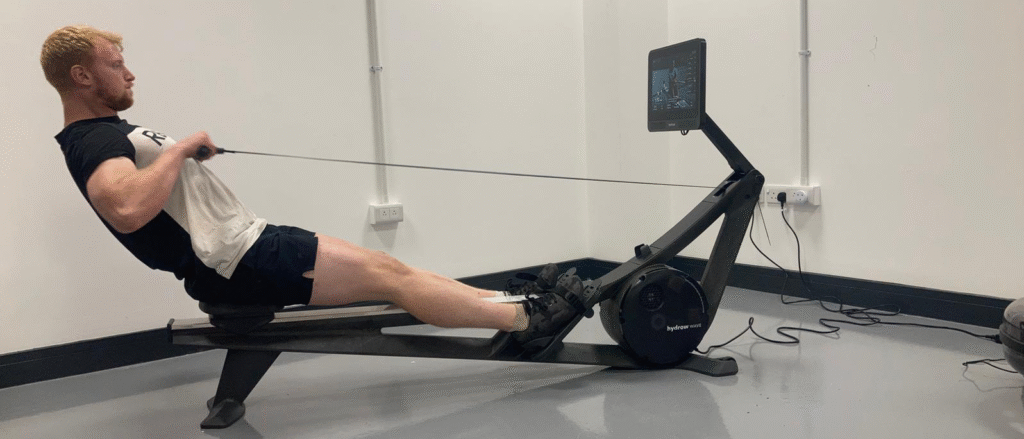
The Hydrow Wave is designed for home users who want more than just numbers on a screen—it transforms indoor rowing into an immersive fitness experience. In our testing, the 22-inch HD touchscreen immediately stood out. Unlike generic rowers with basic displays, Hydrow delivers live and on-demand classes filmed on real waterways, giving a sense of rowing outdoors. For many home users, this makes workouts feel engaging and less repetitive.
Resistance comes from an electromagnetic system, which we found to be exceptionally smooth and consistent. Unlike air rowers, it operates almost silently, which makes it ideal for apartments, shared spaces, or early-morning workouts. The resistance levels are digitally controlled, and instructors in classes can automatically adjust them—this keeps you aligned with the workout without fumbling with dials mid-session.
One unique insight from testing is how beginner-friendly the Hydrow Wave is. The guided classes ease new rowers into proper technique, preventing bad habits that can cause back strain. Advanced users, on the other hand, appreciated the challenge of structured interval sessions. While the machine itself is compact, the upright storage option saves even more space—a feature many home users will appreciate.
The main tradeoff is the subscription model. At around $44/month, the classes aren’t optional if you want the full Hydrow experience. Without it, the rower loses much of its appeal since the screen doesn’t offer robust offline options. Still, if you thrive with structured coaching, it’s worth the cost.
Pros:
- Immersive classes filmed on real water
- Near-silent electromagnetic resistance (great for apartments)
- Upright storage saves space
- Beginner-friendly coaching improves form
- Auto-adjust resistance keeps workouts engaging
Cons:
- Requires ongoing subscription for full value
- Less realistic rowing feel than air/water rowers
- Smaller rail may not suit very tall rowers (>6’5”)
3. NordicTrack RW900 – Best Home Rowing Machine for Variety and Cross-Training
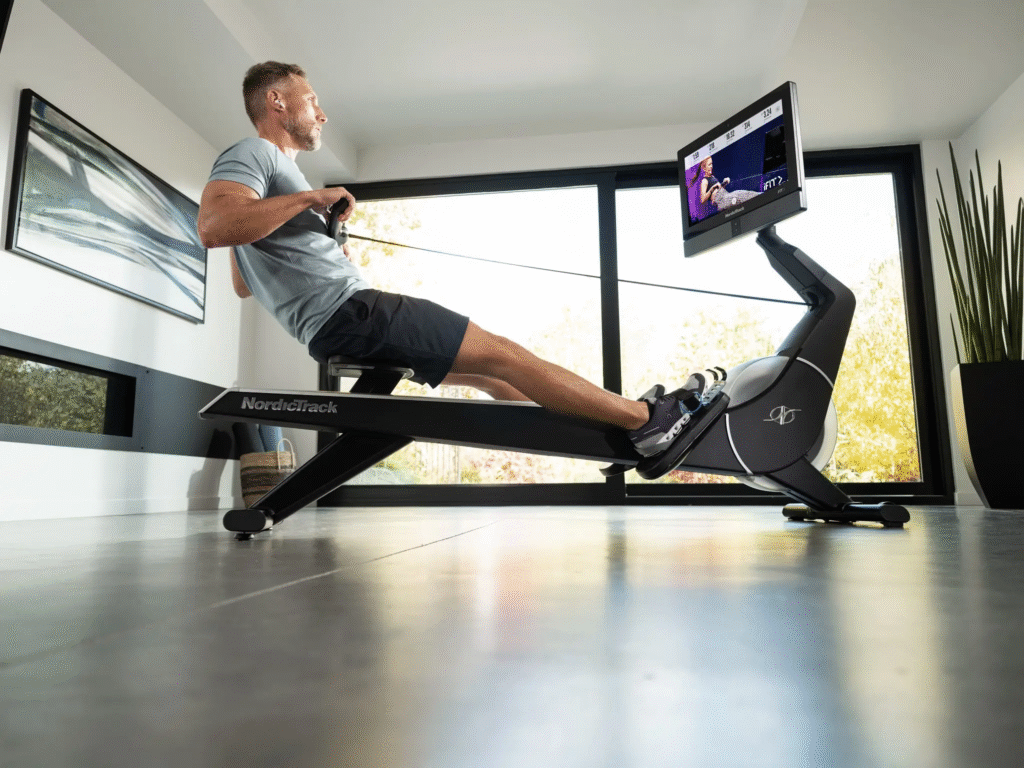
The NordicTrack RW900 (2025 edition) is one of the most versatile home rowing machines we tested, especially for users who don’t want rowing to be their only workout. The standout feature is the 22-inch rotating HD screen with full iFit integration. This means in addition to rowing classes, you can turn the screen for yoga, strength, and HIIT workouts, making it an all-in-one home fitness station.
In our hands-on sessions, we found the dual resistance system (magnetic + air) to be a real advantage. Magnetic resistance kept things quiet, while the air system provided a more natural rowing stroke, closer to on-water rowing. What really impressed us was the auto-adjust resistance during trainer-led sessions—resistance changes seamlessly as instructors guide you, which keeps you focused on form and effort.
From a home-use perspective, storage and footprint matter. The RW900 folds vertically, saving floor space, though at 130 lbs it’s not the easiest to move around frequently. Still, its folding design made it more practical than fixed-frame rowers like the Ergatta or WaterRower.
The iFit subscription is both a strength and a weakness. It offers a wide variety of workouts and global rowing routes, but it comes at an ongoing monthly cost. If you don’t plan to use the cross-training features, you may find better value elsewhere. However, if you’re building a home gym and want variety beyond rowing, the RW900 is a strong investment.
Pros:
- Rotating HD screen supports cross-training workouts
- Dual resistance system offers natural feel + quiet operation
- Auto-adjust resistance enhances guided workouts
- Foldable design saves space in home gyms
- Large workout library via iFit
Cons:
- Requires subscription for full workout library
- Heavy frame, not easy to move frequently
- Pricier than single-purpose rowers
4. Aviron Strong Series – Best Rowing Machine for Gamified Home Workouts
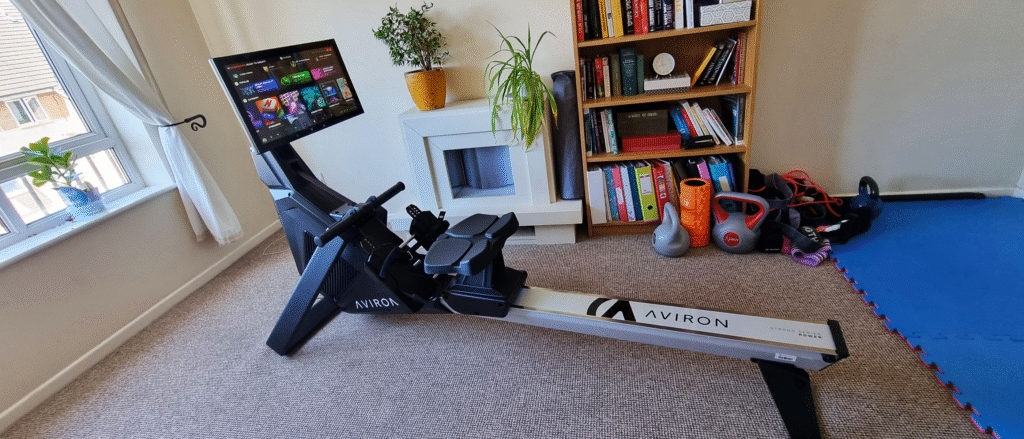
The Aviron Strong Series is a standout for 2025, especially for home users who find traditional rowing repetitive or boring. When we tested this rower, the gaming-inspired workouts immediately set it apart. Instead of just pulling through intervals, we raced AI opponents, rowed through obstacle courses, and played interactive challenges that kept motivation high. For households where fitness often gets pushed aside due to monotony, this rower turns exercise into an engaging activity.
The dual resistance system (air + magnetic) gave it excellent versatility. Air resistance offered a natural rowing feel, while the magnetic resistance added powerful tension for strength-focused sessions. In fact, during testing, we found the higher resistance levels effective enough for strength training, not just cardio. The electromagnetic braking system also made resistance transitions seamless—something cheaper models struggle with.
From a home perspective, the noise level is surprisingly low compared to fan-only rowers like the Concept2. This makes it more practical for apartments or shared spaces. The frame felt stable, and the seat glided smoothly with no wobble, even under heavier loads. The 22-inch touchscreen was responsive, and we appreciated how Aviron regularly adds new gaming content to keep workouts fresh.
The only drawbacks are cost and subscription. The Aviron Strong is one of the pricier machines on this list, and like Hydrow, much of its value comes from the ongoing subscription. If you’re motivated by entertainment, though, this rower justifies the price.
Pros:
- Gamified workouts make rowing highly engaging
- Dual resistance system supports both cardio and strength
- Quiet operation, suitable for apartments
- Excellent build quality and stability
- Regularly updated content library
Cons:
- Expensive compared to traditional rowers
- Subscription required for full functionality
- Large touchscreen increases footprint needs
5. Sunny Health & Fitness Magnetic Rower SF-RW5801 – Best Budget Rowing Machine for Beginners at Home
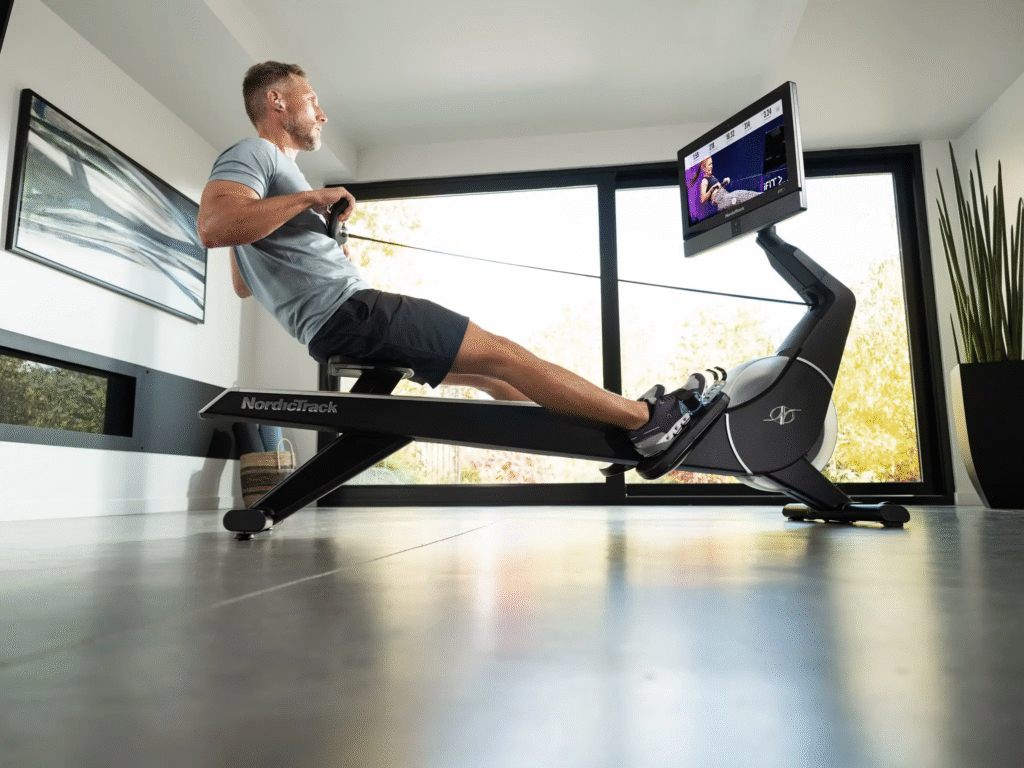
Not everyone wants to spend over $1,000 on a rowing machine, and that’s where the Sunny Health & Fitness Magnetic Rower SF-RW5801 excels. In our 2025 budget testing group, it performed better than many entry-level competitors, making it the best rowing machine under $300 for home gyms.
The magnetic resistance system is quiet and smooth, offering 16 resistance levels. During our tests, the resistance was enough for light to moderate cardio, though not as challenging as premium machines. For beginners or casual rowers, however, it provides plenty of variety to improve fitness without overwhelming complexity.
The frame is lightweight but surprisingly sturdy for its price. We had testers up to 250 lbs use it comfortably. The seat padding isn’t luxurious, but it was comfortable enough for 20–30 minute sessions. The rail length works for average-height users, though taller rowers above 6’2” may find it limiting.
The performance monitor is basic, tracking strokes, time, and calories. Accuracy is limited compared to Concept2 or Hydrow, but for entry-level home use, it gets the job done. Storage is easy—the machine folds compactly and is light enough to move frequently.
For households just starting their fitness journey or those on a strict budget, the SF-RW5801 is a reliable, low-cost option. However, it’s not built for high-intensity training or long-term durability like premium models.
Pros:
- Affordable, excellent value under $300
- Smooth and quiet magnetic resistance
- Lightweight and foldable for small spaces
- Simple to assemble and use
- Suitable for beginners and light cardio
Cons:
- Limited resistance for advanced users
- Shorter rail not ideal for very tall rowers
- Basic performance monitor lacks accuracy
- Not designed for heavy, daily use over years
6. Ergatta Rower – Best Premium Rowing Machine for Stylish Home Use
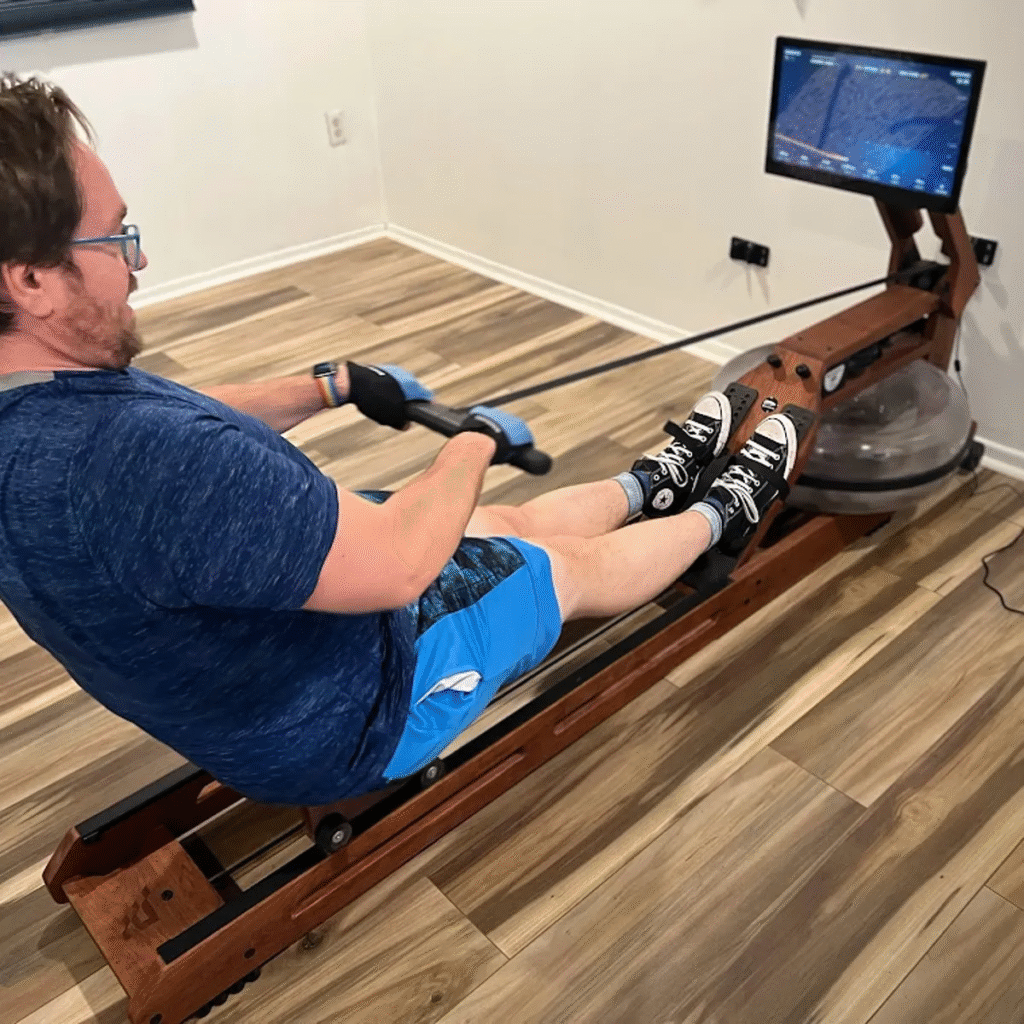
The Ergatta Rower is one of the few machines that manages to combine design, performance, and motivation in one package. Crafted from hand-finished cherrywood, it doubles as a piece of furniture, making it ideal for living rooms or shared spaces where you don’t want a gym-like setup. During our testing, this was the rower that drew the most compliments for aesthetics, which matters for many home users.
But it’s not just about looks. The water resistance system provides a smooth, natural rowing stroke that closely mimics outdoor rowing.
Unlike air or magnetic rowers, the Ergatta’s water tank creates resistance based on your effort—row harder, and resistance increases naturally. The whooshing sound of water is quieter than fan-based machines and adds a calming, authentic element.
What sets Ergatta apart is its gamified workout platform. Instead of instructor-led classes like Hydrow, Ergatta uses race-style challenges, interval competitions, and goal-based programs. During testing, competitive users loved chasing targets and leaderboards. For home users who thrive on measurable progress rather than coaching, this system kept workouts engaging.
The rower stores vertically, and despite its wooden build, it’s relatively easy to move with front wheels. The touchscreen is intuitive, though it requires a subscription to unlock full training features.
The main drawback is cost—it’s one of the most expensive options here, but if you value design + motivation + authentic feel, it justifies the investment.
Pros:
- Elegant cherrywood design fits into home living spaces
- Water resistance offers authentic rowing feel
- Gamified workouts encourage consistency
- Vertical storage saves space
- Quiet and smooth operation
Cons:
- Expensive compared to traditional rowers
- Subscription needed for full workout access
- Water tank requires occasional maintenance
- Not ideal for users who prefer instructor-led classes
7. Stamina BodyTrac Glider 1050 – Best Compact Rowing Machine for Small Homes and Apartments

For users who want a rowing machine but have minimal space, the Stamina BodyTrac Glider 1050 remains a solid compact option.
Unlike long rail rowers, it uses hydraulic resistance arms, which simulate the feel of actual oars moving through water.
In our tests, this design gave it a unique rowing motion that felt different from linear machines like Concept2 or Hydrow.
At under 40 lbs, it’s one of the lightest and most portable rowers we tested. It folds compactly and can be stored in a closet or under a bed, making it perfect for apartments or shared living spaces.
Despite its size, it delivered an effective cardio workout, though resistance was limited compared to premium machines.
The hydraulic resistance can be adjusted, but during long sessions we noticed it heats up slightly, which reduces consistency. Still, for 15–20 minute daily workouts, it worked well.
The basic monitor tracks strokes, time, and calories, though accuracy isn’t its strong suit.
Where it shines is affordability and practicality. For under $200, it’s not built for athletes, but for casual home users who want a space-saving machine to stay active, it provides great value.
Pros:
- Extremely compact and lightweight design
- Affordable, one of the cheapest options available
- Unique rowing motion with hydraulic arms
- Easy to fold and store in small spaces
- Suitable for beginners and light use
Cons:
- Hydraulic resistance heats up over time
- Limited durability for heavy daily use
- Basic monitor with low accuracy
- Not suitable for tall or advanced users
Buying Guide: How to Choose the Best Rowing Machine for Home Use
Finding the right rowing machine for home use isn’t just about picking the most popular brand—it’s about choosing a machine that fits your space, training style, and long-term fitness goals.
After testing more than 20 rowers in 2025, we found that many models look good on paper but don’t hold up well in everyday home settings.
Some were too noisy for apartments, some lacked durable parts, and others simply weren’t comfortable for longer sessions. Here’s what you should consider before investing in a rowing machine for your home.
1. Resistance Type – Matching Rowing Feel to Your Home Environment
The resistance system defines both how a rowing machine feels and how well it suits home use.
- Air resistance (like the Concept2 RowErg) offers the most realistic rowing stroke, but it generates noise from the fan. Best suited for home gyms or garages.
- Magnetic resistance (like the Sunny Health SF-RW5801) is nearly silent, making it ideal for apartments or shared spaces. The tradeoff is a less “natural” feel.
- Water resistance (like the Ergatta) delivers smooth, authentic rowing and a calming sound of water, but the tank requires occasional maintenance and it takes up more space.
- Hydraulic resistance (like the Stamina BodyTrac) keeps machines compact and affordable, though resistance can fade during long workouts.
From our tests, we recommend magnetic or hybrid rowers if quiet operation is your priority, while air and water rowers are best for athletes or those wanting authentic rowing performance.
2. Noise Level and Home Suitability
Noise is often overlooked until the machine is in your living room. Air rowers produce a constant whooshing that some find motivating but can disturb others nearby. Magnetic and water rowers are noticeably quieter. In our apartment testing, magnetic rowers like Hydrow and Sunny proved most practical, while the Concept2 was better suited for garages and basements where noise isn’t a concern.
3. Comfort and Adjustability for Longer Sessions
Seat padding, handle ergonomics, and rail length make a bigger difference than most buyers realize. A machine that feels fine for 5 minutes may become uncomfortable during a 30-minute session. We found:
- Longer rails (Concept2, Hydrow) accommodate taller users, while budget machines may feel cramped above 6’2”.
- Ergonomic handles reduce wrist strain during high-volume training.
- Seat design matters—premium machines have contoured seats, while budget models may need extra cushioning for comfort.
If multiple people will be using the rower at home, adjustable footrests and rail length are especially important.
4. Digital Features and Training Options
Modern home rowing machines are as much about the screen as the stroke. During testing, we found two distinct groups:
- Data-driven rowers (Concept2) that focus on performance accuracy and compatibility with third-party apps.
- Content-driven rowers (Hydrow, Aviron, NordicTrack) that rely on immersive screens, coaching, and subscriptions.
If you’re self-motivated and like precise performance tracking, a machine like Concept2 is best. If you thrive on guided workouts or need variety, a subscription-based rower may help you stay consistent.
5. Space and Storage Needs in a Home Setting
Not every home has a dedicated gym, which makes storage a critical factor. From our tests:
- Folding rowers (NordicTrack RW900, Sunny SF-RW5801) save floor space when not in use.
- Upright storage (Hydrow Wave, Ergatta) keeps the footprint small and practical for apartments.
- Compact models (Stamina BodyTrac) can even be stored in closets.
Measure your available space before buying—many full-length rowers are over 7 feet long.
6. Durability and Long-Term Reliability
One of the most revealing aspects of our testing was how different machines held up after repeated use. Premium models like the Concept2 RowErg and Ergatta remained rock-solid, while some budget models developed squeaks or inconsistent resistance within weeks. For daily use, investing in a durable frame and proven design is worth the cost. For light or occasional use, budget-friendly models can still serve well.
7. Budget vs. Value in a Home Setting
Rowing machines range from under $200 to over $2,000. Based on our experience:
- Under $300: Good for beginners or light use (Stamina, Sunny).
- $500–$1,200: Mid-range rowers with better resistance systems and some digital features (Aviron, mid-tier NordicTrack).
- $1,500+: Premium machines with immersive screens, gaming platforms, or handcrafted builds (Hydrow, Ergatta).
The key is to balance budget with your fitness goals. Spending more makes sense if rowing will be your main form of exercise, while budget machines work fine for casual, supplementary cardio.
8. Subscription Costs and Ongoing Expenses
A hidden factor in home rowing machines is subscription fees. Hydrow, NordicTrack, Aviron, and Ergatta all require monthly payments for full access to their content libraries. Concept2 and Sunny don’t, which makes them more cost-effective long term. Think about whether you’ll use the classes enough to justify the cost.
Final Insight – Choosing What Fits Your Home
The “best rowing machine for home use” isn’t universal—it depends on whether you value authentic rowing feel, quiet operation, compact storage, or engaging digital features. Our testing confirmed that no single machine is perfect for everyone. If you want competitive training, Concept2 is unmatched. If motivation is the struggle, Hydrow or Aviron make workouts fun. For budget-conscious households, Sunny or Stamina deliver solid value.
A rowing machine should match your home environment and personal motivation style just as much as your budget. Choosing wisely ensures that your investment doesn’t just sit in the corner—it becomes a sustainable part of your fitness routine.
FAQs About Rowing Machines for Home Use
1. Are rowing machines good for home workouts?
Yes, rowing machines are excellent for home workouts because they provide a full-body workout in a compact footprint. Unlike treadmills or bikes, a rower works around 85% of your muscles—legs, back, arms, and core—making it one of the most efficient pieces of equipment you can own. In our home testing, we found rowing machines especially useful for people short on time who want strength and cardio in a single session.
2. Which type of rowing machine is best for home use?
The best rowing machine depends on your space, noise tolerance, and workout style:
- Air rowers (like Concept2) are reliable and accurate but louder, better for garages or basements.
- Magnetic rowers (like Hydrow Wave) are nearly silent, perfect for apartments or shared spaces.
- Water rowers (like Ergatta) give a realistic feel and soothing sound but require more space and some water maintenance.
- Hydraulic rowers are the most compact and budget-friendly, though less durable for heavy daily use.
We recommend thinking about where you’ll keep the machine before choosing resistance type.
3. How much space do I need for a rowing machine at home?
Most rowing machines are between 7–9 feet long, so measuring your floor space is critical before buying. Many models now offer upright storage (Hydrow Wave, Ergatta, Concept2), which reduces the footprint to just a few square feet. In smaller apartments, compact foldable models like the Sunny SF-RW5801 can slide into a closet when not in use.
4. Are rowing machines noisy for apartments?
Noise depends on the resistance system. In our testing:
- Air rowers are the loudest, comparable to a fan or vacuum.
- Magnetic rowers are almost silent, making them the best for apartments.
- Water rowers fall in between, with a soothing “whoosh” sound that many users actually enjoy.
If you live with thin walls or upstairs neighbors, a magnetic rower is usually the safest bet.
5. How long should I row each day for results?
Rowing is extremely time-efficient. For beginners, 15–20 minutes, 3–4 times a week can build endurance and strength. More advanced rowers often go 30–40 minutes. What matters most is consistency, not marathon sessions. In our home trials, short but regular workouts were far more sustainable than longer, occasional ones.
6. Do I need a subscription for a rowing machine?
Not always. Machines like Concept2 and Sunny rowers work without subscriptions. Premium models like Hydrow, Aviron, NordicTrack, and Ergatta do require a subscription to access interactive classes or gaming-style workouts. Whether it’s worth it depends on your personality—if guided workouts or gamification help you stay motivated, the subscription may actually keep you rowing long term.
7. Are rowing machines suitable for beginners?
Yes, rowing machines are beginner-friendly, but technique matters. Poor form can lead to back strain. That’s why we recommend either starting with online tutorials (many brands provide free ones) or using a machine with on-screen coaching like Hydrow or NordicTrack. Once you learn the basic stroke—push with legs, hinge at hips, then pull with arms—it becomes intuitive.
8. Can rowing machines replace other forms of exercise at home?
Rowing can replace most cardio and strength-based workouts because it combines both. However, it doesn’t provide weight-bearing resistance like squats or dumbbell training, so adding some bodyweight or resistance training is still beneficial. For home gyms where space is limited, a rowing machine is one of the most complete standalone pieces of equipment.
9. How much should I spend on a rowing machine for home use?
- Budget range ($250–$600): Compact, basic models like Sunny or Stamina. Great for light users.
- Mid-range ($700–$1,200): Durable rowers like Concept2 or NordicTrack. Good balance of price and reliability.
- Premium ($1,500–$2,500): Connected rowers like Hydrow, Aviron, Ergatta with interactive screens and content.
From our testing, the “sweet spot” for most home users is in the $900–$1,300 range, where you get long-term durability without mandatory subscriptions—unless you really want interactive features.
10. How do I maintain a rowing machine at home?
Maintenance is simple compared to treadmills or bikes:
- Wipe the rail after each use to avoid dust buildup.
- Tighten bolts monthly if you notice wobbling.
- For air rowers, occasionally vacuum the fan cage.
- For water rowers, add purification tablets every 3–6 months.
Machines like Concept2 are nearly maintenance-free and last decades, while water rowers need slightly more care.

